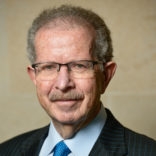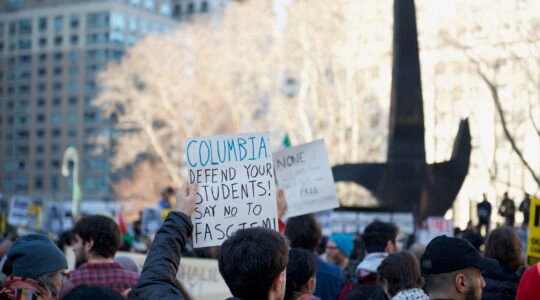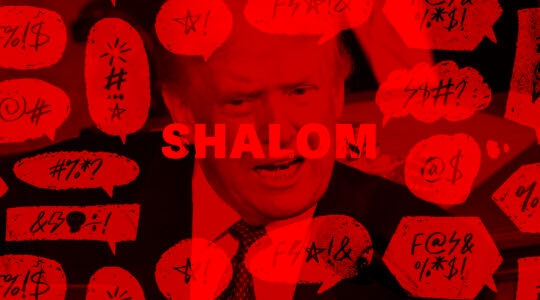NEW YORK (JTA) — It is virtually impossible to imagine anything more reprehensible than the recent spectacle of haredi Orthodox Jewish boys wearing yellow stars of David and simulated striped black-and-white concentration camp uniforms at a demonstration in Jerusalem. Offended by the Israeli authorities’ efforts to curtail the verbal and physical abuse of women and girls in haredi neighborhoods, the demonstrators knowingly and intentionally desecrated the memory of the more than 1.5 million Jewish children whose collective suffering and death will be remembered on Jan. 27 at the United Nations’ annual Holocaust commemoration.
“This protest,” said one of the rally’s organizers, “reflects the Zionists’ persecution of the haredi public, which we see as worse than what the Nazis did.”
The image of one particular boy at the demonstration raising his hands in mock surrender to re-enact the famous photograph of a terrified Jewish child being rounded up by the Germans in the Warsaw Ghetto struck a very personal chord within me. Sixty-nine years ago, another little Jewish boy named Benjamin was living with his parents in the city of Sosnowiec in southern Poland. The previous month he had celebrated his fifth birthday. He was a smart, good-hearted, totally innocent child who had never done any harm to anyone. Only he had already been sentenced to death.
President Franklin D. Roosevelt and Prime Minister Winston Churchill and the other Allied leaders knew full well that Benjamin and virtually every other Jewish child in Nazi-occupied Europe were about to be brutally and systematically murdered. On Dec. 17, 1942, the United States, Great Britain and the USSR had condemned the German government’s “bestial policy of cold-blooded extermination” of Jews in Nazi-occupied or -controlled Europe. Yet Benjamin’s fate and that of other Jewish children like him was not a priority for any government official anywhere.
“Suffer the little children to come unto me,” said Jesus according to the Gospel of Mark. “Forbid them not: for of such is the kingdom of God.” This fundamental Christian imperative was ignored by the U.S. State Department bureaucrats who deliberately frustrated any attempt to come to the rescue of European Jewry. Even in the midst of World War II, if the United States, Great Britain, Canada, Australia and other Western democracies had announced a willingness to give refuge to Jewish children, Benjamin might still have had a chance.
Instead, as Gregory Wallance chronicles in his forthcoming book, “America’s Soul in the Balance, The Holocaust, FDR’s State Department and the Moral Disgrace of an American Aristocracy” (Greenleaf Book Group Press), after Gerhard Riegner, the director of the Geneva office of the World Jewish Congress, had sent a telegram through U.S. diplomatic channels in Switzerland in January 1943 reporting that 6,000 Jews “are killed daily” at one location in Poland, and Romanian Jews are similarly being murdered under dire circumstances, Secretary of State Cordell Hull instructed the American legation in Bern not to accept similar “private messages” in the future.
On the night of Aug. 3-4, 1943, Benjamin arrived at the Auschwitz-Birkenau death camp with his parents and grandparents. In her posthumously published memoirs, his mother, our mother, recalled her final moments with my brother: “We were guarded by SS men and women. One SS man was standing in front of the people and he started the selection. With a single movement of his finger, he was sending some people to the right and some to the left. … Men were separated from women. People with children were sent to one side, and young people were separated from older looking ones. No one was allowed to go from one group to the other. Our 5 1/2-year-old son went with his father. Something that will haunt me to the end of my days occurred during those first moments. As we were separated, our son turned to me and asked, ‘Mommy, are we going to live or die?’ I didn’t answer this question.”
Benjamin, his father and my grandparents were murdered that night in one of the Auschwitz gas chambers. Since my mother’s death in 1997, he has existed inside of me. I see his face in my mind, try to imagine his voice, his fear as the gas chamber doors slammed shut, his final tears. If I were to forget him, he would disappear.
Tragically, the hundreds of thousands of children who were killed in the subsequent 20th century genocides in Rwanda, Darfur, the former Yugoslavia and elsewhere fared no better. The 1948 Convention for the Prevention and Punishment of the Crime of Genocide was supposed to protect them. So was the 1990 Convention on the Rights of the Child, to which Rwanda, Serbia and the Sudan are all parties, which affirmed that “every child has the inherent right to life.” The mutilated corpses of children and infants hacked by machetes in Rwanda or buried in mass graves in Bosnia epitomize the international community’s failure to live up to this most fundamental of all aspirations.
My brother and every other child murdered in any genocide deserve to be remembered as fragile flames extinguished in tsunamis of hatred, intolerance and bigotry. Exploiting their memory to score cheap political points is obscene.
(Menachem Z. Rosensaft, the son of two survivors of the Nazi concentration camps of Auschwitz and Bergen-Belsen, is general counsel of the World Jewish Congress and vice president of the American Gathering of Jewish Holocaust Survivors and Their Descendants. He teaches about the law of genocide at Cornell Law School, Columbia Law School and Syracuse University College of Law.)
JTA has documented Jewish history in real-time for over a century. Keep our journalism strong by joining us in supporting independent, award-winning reporting.






